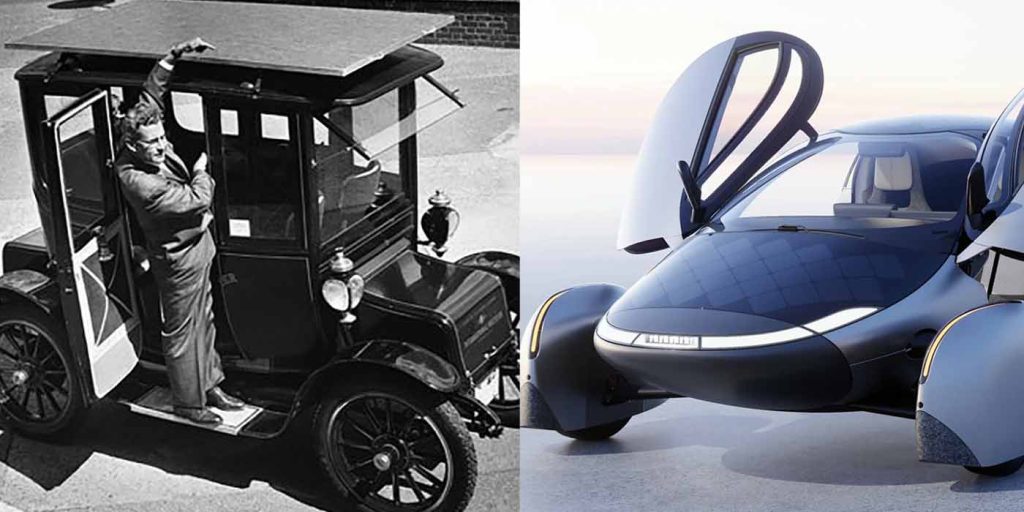
Nearly 70 years ago, the idea of a viable solar car concept was introduced to the world in Chicago, Illinois. While these vehicles started small (literally), they have progressed alongside the sustainable technology segment to a point where scalable solar electric vehicles are closer than ever, but there’s still plenty of room for innovation.
By harnessing the free and abundant energy from our Sun, we are already able to power homes, businesses, and the charging stations that replenish our cars daily, but what about a solar powered car?
In recent years, we’ve seen multiple startups emerge to bring the booming segment of electric vehicles one step further in sustainability, by introducing solar panel technology. Companies like Aptera Motors and Lightyear have tried and failed to reach production, but have found a second life thanks to funding from others who still believe in the technology’s potential.
While we still await scalable solar cars, it’s fascinating to note that these modern day companies were by no means the first to try it. There are other trailblazers that took a crack at it decades before many of us were even born.
On August 31, 1955, GM employee William G. Cobb introduced the “Sunmobile” to a crowd at the General Motors Powerama Auto Show in Chicago, as the world’s first solar-powered automobile. Look closely at the featured image above – notice anything?
Yes, that’s a finger. No, Cobb was not a fairytale-sized giant, I thought the same thing at first. The Sunmobile solar car was actually only 15-inches in length – just a tad too small to fit any human passengers.
No, the visitors to the month-long event were not able to drive the world’s first solar car, but they did marvel at it. More importantly, Cobb’s concept vehicle introduced the world to photovoltaics – the core scientific process of converting the Sun’s rays into electricity. When sunlight hit the 12 photoelectric selenium cells atop the Sunmobile, a zero-emissions electric current actually powered a tiny motor.
This idea inspired many innovators that followed, leading to the first solar car large enough to transport passengers less than a decade later.

The future of solar-powered cars remains partly cloudy
Three years after the debut of the Sunmobile, the International Rectifier Company took a vintage model 1912 Baker electric car (seen above) and converted it to run on photovoltaic energy using a rooftop panel implemented with approximately 10,640 solar cells.
The solar Baker electric car wouldn’t make its public debut until 1962, but still showcased that a passenger vehicle could potentially run entirely from the Sun’s energy. Fifteen years after that, full scale prototypes were demonstrating the same idea, but bolstered by advancements in technology.
This innovation continued through the 1980s as solar powered cars were garnering Guinness World Records for their record breaking trips, including GM’s 1987 Sunraycer. Still, these were one-off competition vehicles and nothing designed for mass consumers.
Today, solar powered cars have gotten a lot sleeker and more efficient thanks to advancements in photovoltaics and aerodynamics, but the world is still nowhere near a future where are able get around using energy from the Sun alone.
Batteries still play a huge role in zero-emissions travel as part of a mobile energy storage system (ESS). That being said, combining solar technology in an EV makes a lot more sense, yet still remains a challenge to deliver.
Companies like Winnebago have implemented solar panels to RV roofs, but they only garner enough energy to power the electronics within the RV, not propel the vehicle itself. Other companies like Lightyear and Aptera have produced much more efficient solar technology, but still – those solar EVs require several hours, if not days in the Sun, to replenish enough energy back.
Furthermore, the funding needed to scale and mass produce electric cars bolstered by solar technology is so great, many of these startups have yet to deliver a production vehicle.
The idea of a 100% solar passenger car that can deliver the performance of a traditional vehicle may not truly ever be possible, but look how far the idea has come since 1955. Solar cell technology will only improve in the future and we are sure to, at the very least, see the technology recharging our vehicle batteries.
It’s an exciting evolution to follow in clean mobility, and it’s awe-inspiring to think how much the technology will have improved in another 70 years. I’ll check back in then – promise.
Author: Scooter Doll
Source: Electrek



